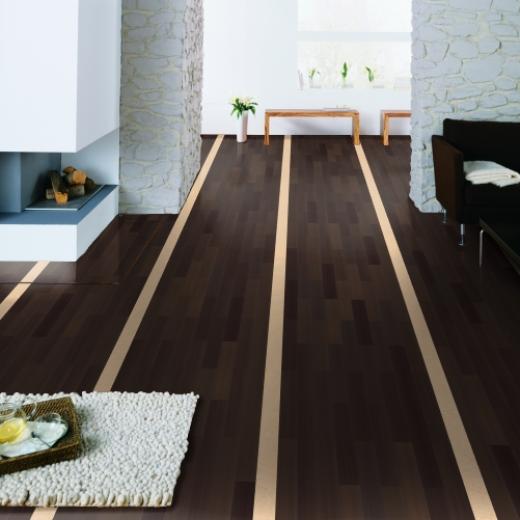When the eye meets the surface... Synchronized grain and pores create a depth-effect on laminate flooring
16 August 2005
The gateway to the third dimension, namely decorative surfaces with synchronized grain and pores, is now the hottest topic in flooring surfaces. Soft, oiled, brushed, planed, whitewashed, natural, exotic or authentic are just some of the options offered by the latest range of laminate flooring products. The haptic effect is increasingly becoming the central feature of the surface both on imitation wood and on stone and ceramic effect decorative surfaces. Modern machine technology makes it possible to produce a perfect reproduction of the natural original. The latest technical advances produce a surface with a three-dimensional appearance which creates a striking sensation of depth.
Synchronized grain and pores are most effective when they are used with wood that has a distinctive character such as oak. They accentuate the rustic effect on both the light and dark versions of oak. Brushed oak or whitewashed smoked oak in many attractive variations as well as naturally oiled, bleached oak were on display at a number of trade shows this year. One of the latest flooring designs features a white pore effect and associated decorative elements. It accentuates the natural texture and contrast of the wood finish and creates a sensation of depth. The color of the various types of wood is decidedly more intense. Apple, pear, American whitewood, very dark cherry and dark brown walnut are typical examples. The trend towards synchronized surfaces also includes exotic wood such as wenge, mahogany, palisander and jatoba, which is clear evidence that laminate flooring is now ready for these types of precious wood.
Wood textures are being produced to an increasing extent as small, single-strip elements or large patters which are cut from an all-over design. The classic two and three strip patterns, which have been highly successful in the market, are also available. Farmhouse boards with V joints are the absolute trendsetters in the wood surface market, and they reinforce the trend towards synchronized grain and pores that create an authentic looking depth effect. In widths of 135 or 195 mm, they have a distinctly narrower and more linear appearance, creating a light, uncluttered effect in confined spaces. However, boards are also available in other widths which can be joined up as rows in any combination. The new single-strip boards with widths up to 90 mm are an attractive solution. They are used primarily as parquet or in a
fishbone pattern.
Authenticity and a genuine appearance are not confined to imitation wood. Stone and ceramic patterns with or without joints are becoming harder and harder to distinguish from the natural original. A Mediterranean ambience in terracotta is currently a very popular stone pattern. The intense natural color creates a warm, cozy ambience in a room. Slate and travertine are used to create interesting effects. Granite and marble stand for elegant floor design. One highlight is a Labrador stone with a very expressive, glistening natural appearance, and it is one of the more distinctive stone decors.
Ceramic tile patterns with joints that have an amazingly realistic 3-D effect combine the recessed appearance of floor tiles with the grainy appearance of cement joints. New small tiles which are 40 cm wide create a very lively pattern when they are installed on a floor. Large tiles (60 x 60 cm and larger) create the typical effect of a stone floor in a Mallorcan finca. In addition to residential settings, stone and ceramic effect tiles are being used to an increasing extent in commercial buildings, department stores, fitness studios, museums, etc., combining innovative design ideas with high-quality flooring.
During the past two years, synchronized grain and pores have been introduced, and the technology for indirect gravure printing on flooring has improved considerably. It will be interesting to see what new decors the laminate flooring industry will come up with in the future. In contrast to multi-layer laminate flooring, with the indirect gravure printing process the décor is printed directly onto the core and is then covered with a lacquer coating. This creates a whole new range of possibilities in floor design for both the décor and the lacquer finish. The new technology will further increase the range of design options and help the product become even more successful.
Contact for press enquiries
Anne-Claude Martin
Press Officer
press(at)eplf.com
Rue Defacqz 52
B - 1050 Ixelles
Phone +32 2 788 31 68
